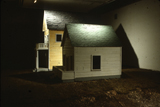From the Outskirts to the Center
| McKeough’s thoughtful and carefully fabricated work bears down on our collective fascination with the artificial and its dubious comforts, on our compulsion to control while ignoring the mess we make.they tear the wall down with their teeth:
The 1993 performance Take it to the teeth features McKeough at her most cunning and demented. Along with performer Cheryl l’Hirondelle, the two spend 41 days literally eating a wall, and spitting out drywall and saliva. Outskirts is also a sly way of looking at feminism, as the motorcycle lady defies stereotypes while her experience edges away from the norm and towards the experimental margins. Wildness as a human and animal reality is obliquely suggested and revealed to be constantly threatened. Domesticated or simply eradicated by encroachment, by consumption and waste, what remains here of wildness are artificial replicas, idiotic toys constantly repeating their programmed movements. sound McKeough is, perhaps even primarily, a sound artist. She began as a drummer, playing with alternative and punk groups in the 70’s and 80’s. Inspired by sounds in the environment, dripping taps, a furnace, she would compose riffs and rhythms, improvising. Her approach to sound is like an excavation, rooted in the body. Where does sound come from, and what obstacles does it encounter on its path from source to articulation? Take it to the Teeth, Bocca al Lupo- In the Mouth of the Wolf, Tower of Silence, and in the recent Outskirts, we see how vocalizations – rage, whispers, utterances, laughter – are offered to the public as glimpses or overt affirmations of authentic, subjective experience. Voices of animals communicate at a level apart from language, yet are still intelligible. Growls, whines, panting compose a lexicon of emotive communication familiar to pet owners everywhere. In her work, McKeough clears space for voices and sounds that are excluded from the official discourse. How is power hoarded through language? Suffice to ask: who is talking, who is being listened to, who is obeyed and who is ignored. More questions arise. Is there something about the very structure of human language – naming and identifying, grammar and reason – that excludes other truths? Language structures thought in ways that lead us to ignore what we are not putting into words.Is not emotional experience far more fluid, at times contradictory, and layered in complexity than what language can encompass? what about those other sounds, so eloquently conveyed by animals and other phenomena, say wind or rain or jackhammers, that express and describe, unhindered by words? Not always golden, silence can be oppressive, a containing and restrictive retention, a camouflage of emotional truth. Voice is ultimately a disclosure, a revealing of interiority. It takes at times a violent gesture to make a voice heard, to bring it to the surface. Over and over again, in gentleness or with force, Rita’s work breaks silence. Over a period of months, with an audio recorder, Mckeough prepared the sound for Outskirts. She recorded sounds of animals, and people mimicking animals, local trains, vehicles, traffic. Singers were hired to contribute voice work to her original melodies and compositions. Overlayed and underlayed is a compendium of urban and rural audio effects. The results are in turn, hypnotic, alarming, disorienting. As in her previous productions, an operatic sense of theatre results from the steady accumulation of effects, an accretion of materials. |
 |
